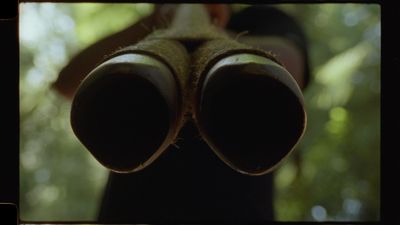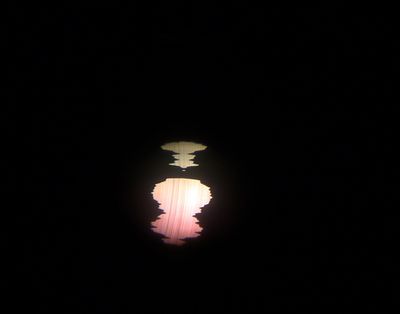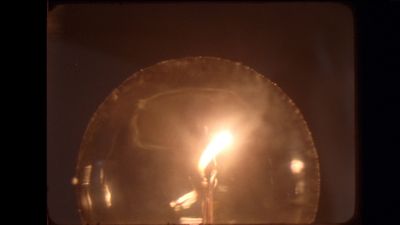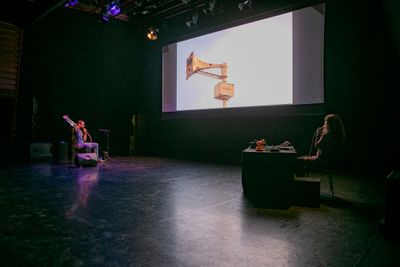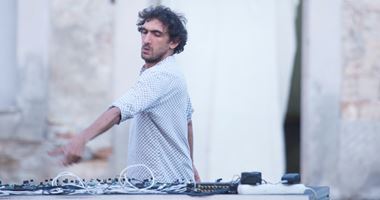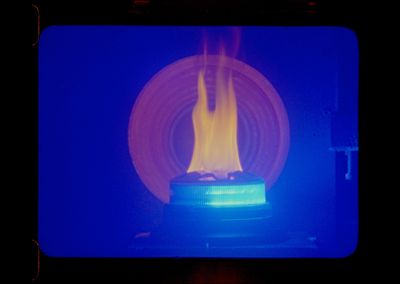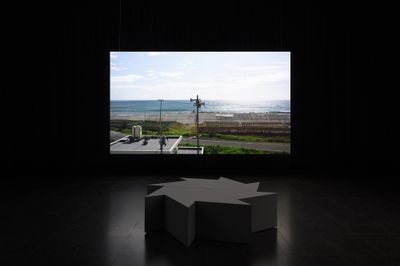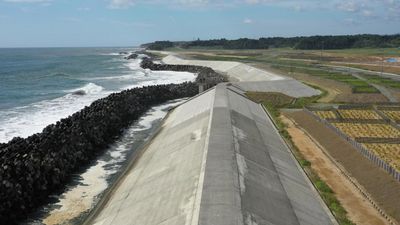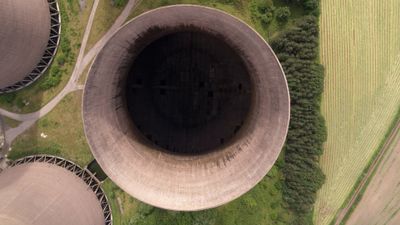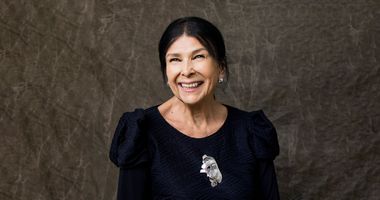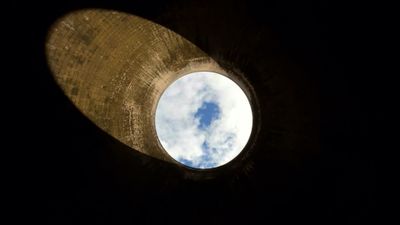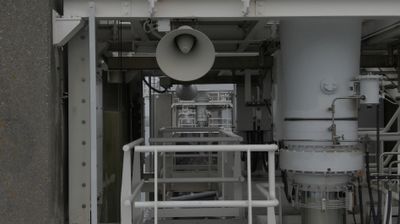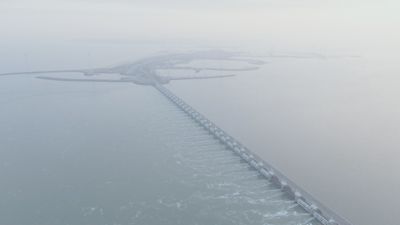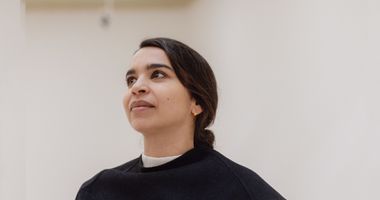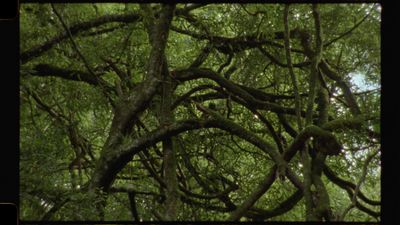Aura Satz Invites Us to Reimagine the Siren
Aura Satz at siren cemetery (2022). Courtesy the artist. Photo: Luke Moody.

Aura Satz at siren cemetery (2022). Courtesy the artist. Photo: Luke Moody.
Premiering in New York this week at the Museum of Modern Art is Aura Satz's debut feature-length film, Preemptive Listening (2024), which considers the concept of the siren and what it might call for.
Listening and attention are central to Satz's practice, whether explored through the moving image, performance, drawing, or sculpture. While her earlier projects zeroed in on the space between sound and source, drawing inspiration from Spiritualist practices and the Surrealist tradition of automatism, Satz's later works have approached sonic technologies and their lesser known origins, such as in her filmic portraits of composers Daphne Oram, Laurie Spiegel, and Beatriz Ferreyra.
Satz and I first worked together in 2019 at the Berwick Film and Media Arts Festival, where she presented her short film, Preemptive Listening (part 1: The Fork in the Road) (2018), which inaugurated the Preemptive Listening project.
Following my return to Aotearoa New Zealand during the Covid-19 pandemic, I served as associate producer for the part of Preemptive Listening filmed at Maungatautari (Sanctuary Mountain), a nature reserve in Aotearoa's North Island. Created in collaboration with taonga puoro [Māori musical instrument] expert, Horomona Horo, and the legal scholar and activist Erin Matariki Carr, this segment brings Indigenous worldviews into focus. Like several other parts of Satz's film, it was first presented as a standalone work, entitled A Pluriverse Siren (2023), at Te Uru Waitākere Contemporary Gallery in Tāmaki Makaurau Auckland.
Shot in 19 locations, Preemptive Listening (2024) is Satz's most ambitious project to date and the culmination of years of reflection with over 20 collaborators who were asked to reimagine what a siren could be. Among these are the Pulitzer Prize-winning composer Raven Chacon, and musicians Kode9, Sarah Davachi, Mazen Kerbaj, Elaine Mitchener, Moor Mother, Camille Norment, Laurie Spiegel, David Toop and FUJI|||||||||||TA.
Alongside these contributors' new sonic propositions, Satz's words and those of several scholars, activists, and organisers give the film its discursive framing—at times oblique, in other moments through direct modes of address. In a more poetic register, Satz describes the film as 'an ode to sirens past and present'. But it is the question of futurity, of listening ahead, that animates Preemptive Listening: how might we envision new sirens, not only scored to immediacy, as sirens are most commonly deployed today, but as signals sounding an alarm for a distant future?
Following its world premiere at MoMA, Preemptive Listening will have its European premiere at Copenhagen International Documentary Film Festival next month, and a U.K. premiere at Tate Modern in April, where it will be accompanied by a three-day programme of music performances and a symposium with several of the film's contributors.
In the following conversation, Satz revisits the projects that led her to focus on the siren, and recounts working with collaborators as wide-ranging as mental health workers, actors, musicians, and siren collectors. Through reimagining the siren's call beyond a warning for crises, Satz proposes what she calls 'a score for listening with the future in mind.'
TJMYou have worked with glissando sounds—produced by a rapid, smooth slide between notes—and flickering stroboscopic patterns—where continuous motion is broken into flashing sequences—in your films for a long time, which led you to your long-term project on the siren. What drew you to this subject?
ASIn previous works I attempted to modulate attention through reconfiguring listening and looking. For example, In and out of Synch (2012), which was co-scripted and voiced with artist and filmmaker Lis Rhodes, featured abstract patterns of our voices encoded as light onto the soundtrack area of the 16mm and 35mm filmstrip. These quivering, strobing, voice-activated lights, which were produced by the optical sound camera, present an image of a sound wave in formation. They suggest a code of sorts—a secondary system of communication, beyond language, creating a friction between sound-image synchronicity.
The film is a prompt, an invitation to ... recalibrate what we understand as worthy of attention—a score for listening with the future in mind.
This logic continues in Preemptive Listening, especially the segment with the actor and activist, Khalid Abdalla, whose voice drives an emergency light's rotation and pacing. He is literally the voice of emergency, but, as he says in the film in relation to his involvement in the Arab Spring, 'I try to keep alive my version of the emergency... as opposed to the method of crisis management that is around us', and this requires constant 'unlearning... rewriting, rereading'.
This notion of unsettling is an undercurrent in all of my earlier works that look at systems of notation, code, encryption technologies, or the shape-shifting of acoustic devices such as a Chladni Plate or Rubens tube. These systems were all new ways of communicating, sonically or otherwise, but also potentially new ways of relating and being in the world, which is really the focus of Preemptive Listening.
TJMHow has your research into the siren pushed you into new ways of thinking and working?
ASThough Preemptive Listening is the culmination of many previous works, I think it actually allowed me to break free from my earlier, more archival methods. In some ways, the more documentary-style footage of current sirens can be understood as a historical document—an archive of sirens—but the sounds and voices are speculative, propositional, and forward-facing. The film is a prompt, an invitation to shift and recalibrate what we understand as worthy of attention—a score for listening with the future in mind.
TJMYour 2018 short film, Preemptive Listening (part 1: The Fork in the Road), inaugurated the project, and saw you collaborate with Mazen Kerbaj and Khalid Abdalla. How did that collaboration come about?
ASIn 2017, I invited several musicians to compose a new siren sound. I came across Mazen Kerbaj's incredible piece, 'Starry Night', which he describes as 'a minimalistic improvisation by: Mazen Kerbaj / trumpet, the Israeli air force / bombs', 'recorded on the balcony of his flat in Beirut, on the night of 15th to 16th of July 2006', during Israel's summer war against Hezbollah in Lebanon.
I knew Mazen would respond to my invitation with something extraordinary, and that this exchange—like all of them—would set me on a new path. His siren proposition was defiant, rousing, and centrifugal—partly due to his 'prepared trumpet' technique of spinning the trumpet around. But also, as a sound, it draws you in and pulls you upwards, like a clarion call.
The siren shapes a listener, and likewise, you could say it is a public address system that cultivates a public.
Khalid came to this project by chance. I had invited him to speak at the Royal College of Art on his work with the Mosireen Collective (a volunteer media activist collective that came together to document and transmit images of the Egyptian Revolution of 2011). Over lunch, when the siren topic came up, he said he had an intense experience from the Arab Spring which he wanted to share. When we met for an interview, his words completely floored me. Everything he said was perfectly phrased, like droplets of poetry—full of trauma but also yearning.
I put both siren propositions together as a first pilot, and spent a good three or four frustrating years trying to get the project funded. Every time I listen back to the chapter with Khalid, I feel it's the point from which the rest of the project followed. The music and words invoke the ideas of alarm, all'arme, or 'a call to arms', and ignite this sense of an 'otherwise'—a different possibility, which is central to the film. Khalid also coached me for my voiceover parts in the feature, not just because of his work as a professional actor, but because I felt that my tone would be inflected by his listening, and draw out a specific intensity and intention.
TJMIn several parts of the feature-length version, stroboscopic lighting is the only image you provide. What relationships between image and sound do these moments set up?
ASFor me, the voice-activated light resonates with a beacon or lighthouse. It's as if the interviewees' voices are themselves an emergency light, forging an alternative pattern and reading of the siren. I think of them as 'beacon voices', though as the film unfolds, those five chapters start to dissolve the logic of a close synchronicity between sound and image.
I wanted to allow the viewer to really bask in their voices—to listen deeply to the grain, texture, and emotion of their voices without being distracted by their faces on screen. The film is shot using drones or digital camerawork, except for the five chapters of interviews which are shot on 16mm film, to echo the photosensitivity of my previous optical-sound films. I also wanted something intimate, frail, and shimmering to contrast with the smooth, disembodied, and militarised bird's-eye view of the drones.
To me an abolitionist framework is part of the desire to set the project within the horizon of an otherwise.
TJMThe siren operates within what you refer to in the film as the 'war-weather continuum'. What does this term mean and how has it helped you navigate the vast subject of the siren?
ASThe philosopher Brian Massumi writes about the war-weather continuum as an entanglement of climate catastrophe and political conflict. The siren is literally the embodiment of this, insofar as many sirens that were historically used to warn of air-raids or nuclear attacks are now repurposed to signal for extreme weather, especially in the U.S. I haven't found much literature on this but it came up in all of my conversations with siren manufacturers, as well as siren collectors and enthusiasts. So there is effectively a war-weather continuum underpinning the siren's material history and its sonic associations.
Massumi also writes about 'preemptive power' to describe the post-9/11 operative logic of our time, where we are perpetually innervated to an indeterminate sense of threat. I came across his writing after I had come up with my title, and I use the word differently, in that, even if it is attuned to threat, preemptive listening holds space for possibility. It is more concerned with care and survival, in the way that we understand an ambulance siren as the sound of rescue.
TJMIn the Fukushima section you highlight the siren's failure to register deep time. Can you say more about this?
ASMany sirens are ineffective, inaudible, false, or impossible warnings. The siren is a useful sonic provocation to expand our understanding of emergency frameworks beyond a singular incident (such as a fire) and an immediate, responsive course of action. Even over the seven years that I've been making the film, the many wildfires and floods are clearly indicating wider, interconnected climate catastrophes that cannot be resolved by merely putting out one fire, so to speak.
So the idea of rendering a siren for the deep future is a philosophical quandary—as the film states, 'Some warnings cannot warn enough'. Sirens are not the answer to these problems, but they are useful for getting us to think about how we might sound the alarm for the unimaginable beyond this lifetime (climate change, nuclear waste, extinction), how we might warn the distant future, and become good ancestors for the planet.
TJMIn Fukushima and the Netherlands, the preventive architectural aspect of the siren meets its physical analogue in the form of the seawall and the Oosterscheldekering storm surge barrier respectively. How did you approach the task of image-making for Preemptive Listening when confronted with such a diverse set of possibilities?
ASWalls and barriers are almost always near sirens, and even if you think of a burglar alarm, the siren is often the sound that marks a trespass—it is there to signal an overspill, an invasion, or the threat of borders being breached. The sirens near the seawall in Fukushima and along the Oosterscheldekering reiterate this logic, but also unravel it—disaster does not keep to borders. For example, when we filmed a water tower in Lapland, I was told that the siren is also there to signal industrial leaks and neighbouring nuclear fallout, given that Chernobyl's nuclear disaster affected other regions such as Finland and Denmark.
TJMLike the decommissioned coal-fired power station which was featured in your project, The Grief Interval (2021), the siren graveyard draws our attention to the afterlife of industry and its technologies, many of which are or will become obsolete. What exactly is the siren graveyard?
ASI worked remotely with a wonderful siren collector and cameraman named Brandon Mendel, who I found online in 2020 as I was trying to put together the film pitch and trailer. He knows all of the different model types—what sound they make, where and when. He mentioned this incredible site of a siren cemetery, which is essentially a junkyard.
When we finally met in person and did the shoot there at night it was really spectacular. The mute, rusty sirens were covered with overgrowth; the air was dense with insect sounds, maybe even some frogs. I wanted this section to suggest a release from these outmoded sirens, and the accompanying siren soundscape by the musician Debit is like otherworldly time travel, evocative of both ancestral as well as future voices or entities.
TJMThe film also takes us into siren factories. We see various forms of stress testing for pulsing lights—the kind used on emergency vehicles—including a chamber which simulates a storm. What made you want to depict these spaces?
ASMany technologies are modelled on our anatomy—they are extensions of us. I wanted to get closer to the sirens, to see them as a 'circuit of an ear and a mouth, listening out for threat and broadcasting it to the population', to quote the film. Another thing that struck me was how the siren mostly inhabits the preemptive moment, before disaster strikes. Many of them are modular components at the service of different war-weather contexts, but at the point of fabrication are not yet assigned their landscapes of threat, nor their listeners. I especially liked the tests which are designed to see whether the siren can survive the conditions in which it warns.
TJMYou describe the grammar of the siren as imperative: one of authoritative, unidirectional command. In their contributions, the activists and organisers Asantewaa Boykin and Niki Jones take to task this function, making a case for more responsive, community-oriented approaches to mental health emergencies and harm reduction. In what ways does an abolitionist framework inform Preemptive Listening?
ASThe siren shapes a listener, and likewise, you could say it is a public address system that cultivates a public. I was acutely aware of how the siren operates within a sonic colour line—the racial determination of the politics of listening—and that for many, the siren is first and foremost the sound of unsafety, as Asantewaa states, that overlaps with the prison-industrial complex through policing and incarceration. To me an abolitionist framework is part of the desire to set the project within the horizon of an otherwise.
The natural environment is itself an entity or voice . . . that offers a very different understanding of how we might attune or listen.
Asantewaa Boykin and Niki Jones are the co-creators of Mental Health First, a non-police response to mental health crises whose mission is to provide 'de-escalation assistance, and non-punitive and life-affirming interventions, therefore decriminalising emotional and psychological crises'. As Asantewaa says in the film: 'MH First shifts the culture of mental health response, so that that siren can mean the same for you, for me, for whoever hears it.'
It was really powerful to try to imagine how one might re-conceptualise a siren that is for care and equal right to safety, equal right to survival. I love when Niki says, 'for me, a siren that is needed, we would want to respond to, because it moves us and because we'll be better off.'
TJMThe question of who is the threat and who is threatened finds its way into the section of the film on Israel and Palestine. You invoke the siren's function as a mnemonic device, used for commemorating both the Holocaust and the Nakba. What was it like making this part of the film, and how does it feel to see it from the vantage point of the present, in its undeniable horror but also its uncertainty?
ASThis part of the film, though only four minutes of almost 90, was the most challenging and has remained the most painful, for so many reasons. In the film there's this sentence: 'Each siren is a lament, invoking the dead and cautioning the living'. This plays out very literally with the commemorative sirens in Israel, which bring the country to silent standstill on Holocaust Remembrance Day (YomHaShoah) and Memorial Day (Yom HaZikaron).
Not only do Palestinians inevitably hear Israeli sirens during these ceremonial instances, but they also hear it alerting of missile strikes, and understand it as a siren for some but not others. The asymmetry is further articulated through Palestine's lack of civil defence sirens (or safe shelters). I was told that Palestinians commemorate the Nakba using a siren that is broadcast on the radio and through Minaret loudspeakers. This siren is ongoing and incremental, measuring the years since their mass displacement and dispossession in 1948. It was 75 seconds long in 2023; this May it will be 76 seconds, and so forth. I have watched and rewatched this sequence in the film, uncertain of whether it can adequately speak to the current circumstances.
TJMIn Aotearoa New Zealand, your collaboration with the taonga puoro [Māori musical instruments] expert Horomona Horo and the activist and legal scholar Erin Matariki Carr centred an Indigenous point of view. One of its signal contributions is representing a firm challenge to human-centred thinking by way of what Carr refers to as a "kincentric" approach, informed by Te Ao Māori, or Māori worldviews, and her interaction with other Indigenous peoples. Why was this especially important for you to include?
ASWe urgently need an alternative 'pluriverse' worldview, to quote Matariki, in addressing climate catastrophe. Matariki's words and Horomona's music are a necessary balm that crucially articulate the importance of our kinship with the non-human and more-than-human. But it is also a powerful critique which sees sirens as colonial impositions of authority, as Matariki says explicitly, as well as quintessentially anthropocentric—centred on the loss of human life or property at the expense of the living systems we are part of. The natural environment is itself an entity or voice that Horomona's playing is in dialogue with—birdsong in response to his music, for example—that offers a very different understanding of how we might attune or listen.
TJMThe film concludes with anthropologist and environmental philosopher Arturo Escobar, who proposes design as something beyond a specialist discipline, and more as a form of worldmaking which calls upon all of us to participate. What are your aspirations for the film and how it might be taken up in this vein?
ASArturo puts forward a wonderful suggestion that emergency contains within it the possibility of emergence—the arising of something that is genuinely new, and that in a crisis there is also an opening. In conversations with the project's research associates, Irene Revell and Francesca Laura Cavallo, we frequently discussed the idea of a text score, inspired by Pauline Oliveros' Sonic Meditations—especially the one that reads, 'Keep the next sound you hear in mind for at least the next half hour'—alongside the idea of a survival manual or emergency instructions. There's a tension between the open score invitation to engage in Deep Listening—to be improvisational and un-hierarchical—and the idea that there are some useful, necessary, and good sirens that—at least theoretically—exist as preemptive and protective measures. —[O]




